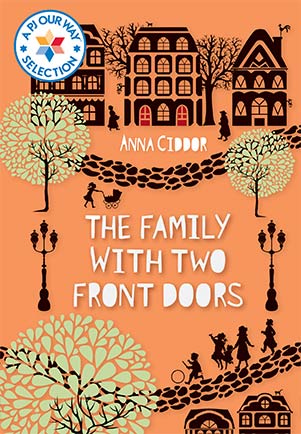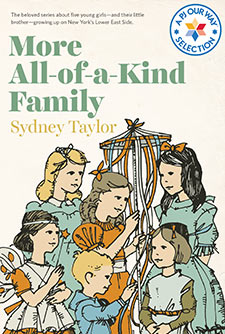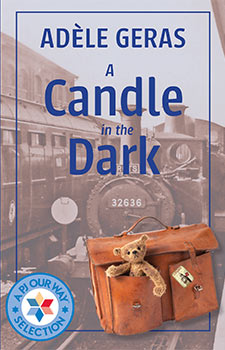The Family with Two Front Doors
When Papa comes home with the news that their big sister is to be married, Adina’s younger sisters are excited, but 15-year-old Adina isn’t so sure. How can she marry a boy she’s never met?!
Average Rating
( hint: Login to leave a review! )
81 Reviews
Leave Review
What the Book Is About
Jewish Content & Values
Positive Role Models
Content Advisory
Talk It Over
More for You
What the Book Is About
Life in the close-knit Rabinovitch household is full of children, adventures, and food! Then one day Papa announces that a husband has been found for 15-year-old Adina – and she won’t meet him until her wedding day! Told mostly through the eyes of 10-year-old Nomi and mischievous Yakov, this charming book has been compared to Little Women, Little House on the Prairie, and All-of-a-Kind Family. The children have strong personalities and there is plenty of gentle humor and detail about Jewish life and traditions in 1920s Poland. Despite the historical setting, the writing is very fresh. Parents will enjoy this book as much as their children.
Jewish Content & Values
- Ashkenazi Jewish food features heavily: there are descriptions of making gefilte fish, making challah, making kugel, buying the ingredients for cholent, koshering a chicken, checking that the eggs are kosher, and more.
- Mama wears a sheitl (wig), and Adina will cover her hair with a sheitl when she is married.
- Papa Rabinovitch is a rabbi and is raising his sons to be learned in Torah. Every Friday evening, the men in the community gather in the shtiebl (a small, informal house of prayer) for the prayers that lead into Shabbat (sabbath).
- The rituals of a Shabbat meal are described, including blessing the children, making kiddush (blessing over the wine), and making hamotzi (blessing over the bread).
- The rituals of a Jewish wedding are described, from Adina’s haircut and first sheitl, through the ceremony.
- Every Thursday all the households in the community open their doors to hungry townspeople and give them food or a little money, fulfilling the mitzvah of tzedakeh.
Positive Role Models
- Papa Rabinovitch is a rabbi with expectations of his children to learn Torah and follow Jewish laws and traditions. He has a sense of fun and is loving towards his children, taking care to choose a husband for Adina who is kind and learned, and who he thinks she will love.
- Mama Rabinovitch is a matriarch who keeps a traditional Jewish home, and who gives her children freedom to have fun and to make mistakes and learn from them. She nods to modernity by surprising her daughter with a sheitl in a fashionable bob hairstyle and sells her favorite jewelry to pay for Adina’s dowry, the wedding, and an apartment for the newlyweds.
Content Advisory
There are a few instances of antisemitic taunts in the book. When the children go on a picnic, people follow them and start throwing stones until the Christian maid fends off the assailants. The afterword explains that the book is based on the author’s grandmother’s childhood and reveals that only three of the children survived the Holocaust.
Talk It Over
In the Orthodox Jewish community of 1920s Poland, arranged marriages were the norm, and they still take place in some communities and cultures today, including the Haredi (ultra-Orthodox Jewish) community. Why do you think certain communities maintain this custom in today’s modern age?
More for You
Many people’s knowledge of arranged marriage comes from Fiddler on the Roof. Tevye’s daughters want to follow their own hearts, and Tevye questions the notion of love and wonders whether he loves Golda, his wife in an arranged marriage. A Jewish arranged marriage is called a shidduch and the matchmaker is a shadchan. Today, the bride and groom in a Jewish arranged marriage are usually introduced and go on some dates before deciding whether to accept or reject their prospective spouse.
What the Book Is About
What the Book Is About
Life in the close-knit Rabinovitch household is full of children, adventures, and food! Then one day Papa announces that a husband has been found for 15-year-old Adina – and she won’t meet him until her wedding day! Told mostly through the eyes of 10-year-old Nomi and mischievous Yakov, this charming book has been compared to Little Women, Little House on the Prairie, and All-of-a-Kind Family. The children have strong personalities and there is plenty of gentle humor and detail about Jewish life and traditions in 1920s Poland. Despite the historical setting, the writing is very fresh. Parents will enjoy this book as much as their children.
Jewish Content & Values
Jewish Content & Values
- Ashkenazi Jewish food features heavily: there are descriptions of making gefilte fish, making challah, making kugel, buying the ingredients for cholent, koshering a chicken, checking that the eggs are kosher, and more.
- Mama wears a sheitl (wig), and Adina will cover her hair with a sheitl when she is married.
- Papa Rabinovitch is a rabbi and is raising his sons to be learned in Torah. Every Friday evening, the men in the community gather in the shtiebl (a small, informal house of prayer) for the prayers that lead into Shabbat (sabbath).
- The rituals of a Shabbat meal are described, including blessing the children, making kiddush (blessing over the wine), and making hamotzi (blessing over the bread).
- The rituals of a Jewish wedding are described, from Adina’s haircut and first sheitl, through the ceremony.
- Every Thursday all the households in the community open their doors to hungry townspeople and give them food or a little money, fulfilling the mitzvah of tzedakeh.
Positive Role Models
Positive Role Models
- Papa Rabinovitch is a rabbi with expectations of his children to learn Torah and follow Jewish laws and traditions. He has a sense of fun and is loving towards his children, taking care to choose a husband for Adina who is kind and learned, and who he thinks she will love.
- Mama Rabinovitch is a matriarch who keeps a traditional Jewish home, and who gives her children freedom to have fun and to make mistakes and learn from them. She nods to modernity by surprising her daughter with a sheitl in a fashionable bob hairstyle and sells her favorite jewelry to pay for Adina’s dowry, the wedding, and an apartment for the newlyweds.
Content Advisory
Content Advisory
There are a few instances of antisemitic taunts in the book. When the children go on a picnic, people follow them and start throwing stones until the Christian maid fends off the assailants. The afterword explains that the book is based on the author’s grandmother’s childhood and reveals that only three of the children survived the Holocaust.
Talk It Over
Talk It Over
In the Orthodox Jewish community of 1920s Poland, arranged marriages were the norm, and they still take place in some communities and cultures today, including the Haredi (ultra-Orthodox Jewish) community. Why do you think certain communities maintain this custom in today’s modern age?
More for You
More for You
Many people’s knowledge of arranged marriage comes from Fiddler on the Roof. Tevye’s daughters want to follow their own hearts, and Tevye questions the notion of love and wonders whether he loves Golda, his wife in an arranged marriage. A Jewish arranged marriage is called a shidduch and the matchmaker is a shadchan. Today, the bride and groom in a Jewish arranged marriage are usually introduced and go on some dates before deciding whether to accept or reject their prospective spouse.



